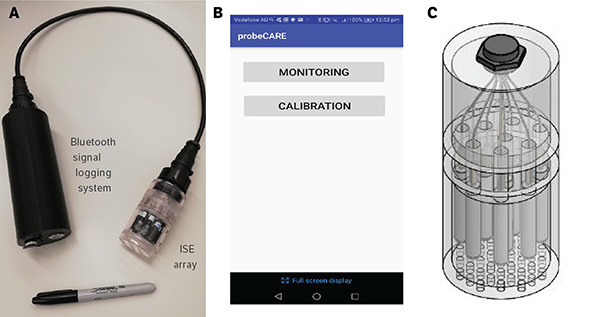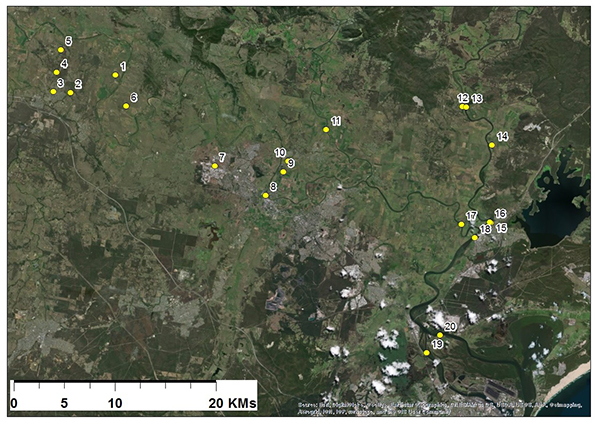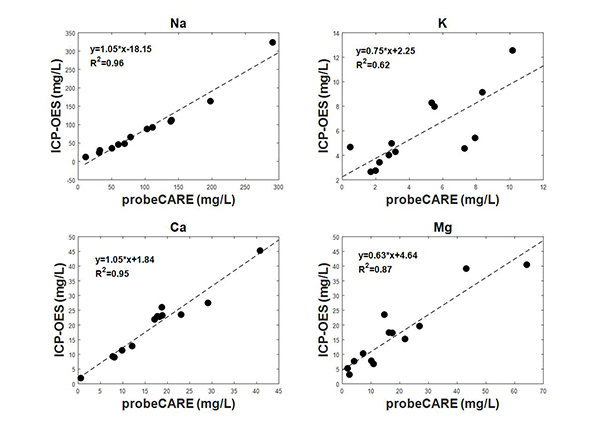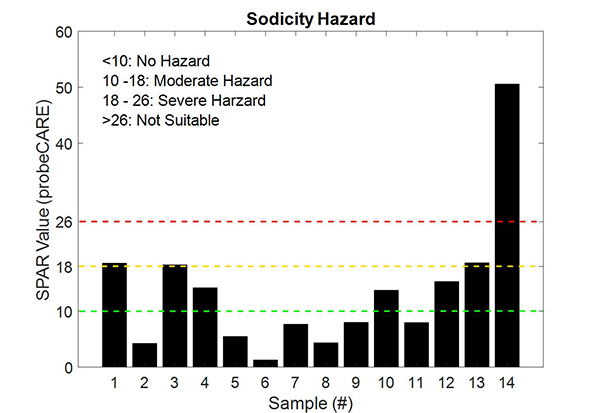Content
Validating probeCARE™ in field tests
Validating probeCARE™ in field tests
CRC CARE developed probeCARE™ to support cost-effective, in situ, real-time monitoring of water. This is used to improve management strategies for cropping and fertigation, using recycled water effectively and monitoring for possible pollutants to meet environmental protection agency standards.
probeCARE and its function
probeCARE is an ion-selective electrode (ISE) array, coupled with a Bluetooth signal logging device and a smartphone app (see Figure 1 for the new prototype). The miniature ISEs used – 30 mm long and 6 mm wide – have a solid-state electrode body with different ion-selective membranes. A housing unit can hold up to 12 ISEs, including a reference electrode, in an array. The data-logging system can simultaneously record and send all the signals from the ISE array to the smartphone app via a Bluetooth connection with a 1-second interval. The smartphone app has patented algorithms to simplify the ISE array calibration, and improve the prediction accuracy by eliminating the interference from undesired ions.1,2

Field validation
To validate the field performance of probeCARE, we used it to measure 4 exchangeable cations – sodium (Na), potassium (K), calcium (Ca), magnesium (Mg) – in 20 surface water sources from the Hunter region, New South Wales (see Figure 2). Six different creek waters (samples 1–3, 5, 6 and 14) and 6 reserved or pond waters (samples 4, 7, 9, 10, 12 and 15) were also measured in situ using probeCARE. Furthermore, water from the Hunter River was also measured in several locations. The upper Hunter River is separated into 3 different rivers: the Williams, Peterson and Hunter rivers. The waters of these 3 rivers have been tested at Seaham (sample 13), Woodville (sample 11) and Maitland (sample 8), respectively. The 3 rivers merge into the Hunter River at Raymond Terrace (samples 16–18). The Hunter River is separated into 2 channels (south as sample 19 and north as sample 20) before it reaches the Pacific Ocean.

For comparison, 2 samples from each water source were collected and sent to the Global Centre for Environmental Remediation, University of Newcastle, to be measured using conventional inductively coupled plasma optical emission spectrometry (ICP-OES). Figure 3 compares the results from probeCARE and ICP-OES. Samples 15–20 are salty water samples, with high sodium chloride concentrations that are not suitable for irrigation. Therefore, the results for these 6 samples are not shown. For the rest of the samples, the results showed that:
- Na concentrations were around 10–300 mg/L
- K concentrations were <10 mg/L
- Ca and Mg concentrations were <100 mg/L.
Figure 3 shows the linear relationships between the ICP-OES and probeCARE results.

Sodicity hazard estimation
A major problem concerning the quality of irrigation water is the level of monovalent cations (Na and K) in the water. This is known as sodicity hazard, and it influences the structural stability of clay minerals and potential for dispersion, erosion and drainage.3 It can be indicated by the sodium–potassium adsorption ratio (SPAR), in terms of the relative proportion of monovalent cations, compared with bivalent cations (Ca and Mg) in solution.4 If the bivalent cations are more dominant in the solution than the monovalent cations, the danger is minimal – and vice versa. The SPAR values calculated using probeCARE are shown in Figure 4. Most of the water samples were within the no or moderate sodicity hazard zone. High SPAR values were detected from samples 14–20, which indicates these water sources are not suitable for irrigation.

SPAR = sodium–potassium adsorption ratio
Notes:
<10: no hazard (below the green line)
10–18: moderate hazard (between the green and the yellow line)
18–26: severe hazard (between the yellow and the red line)
>26: not suitable (above the red line)
Conclusion
The interference from undesired ions is a major challenge of using ISEs. For instance, in our results, Na concentration varies from one to hundreds of mg/L in the water samples we measured. According to our previous studies,1,2 Na can significantly interfere with ISE measurements, especially when Na dominates in highly saline water. Since the results from both measurement systems closely align, we show that probeCARE can eliminate the interference from Na and provide accurate measurements.
References
- Wang L, Yang D, Lamb D, Lesniewski PJ, Megharaj M, Naidu R (2015). Application of mathematical models and genetic algorithm to simulate the response characteristics of an ion selective electrode array for system recalibration. Chemometrics and Intelligent Laboratory Systems 144:24–30.
- Wang L, Yang D, Fang C, Chen Z, Lesniewski PJ, Megharaj M, Naidu R (2015). Simultaneously determinate four exchangeable cations based on a Prussian blue modified glassy carbon electrode array. Talanta 131:395–403.
- Liu M, Yang J, Li X, Yu M, Wang J (2012). Effects of irrigation water quality and drip tape arrangement on soil salinity, soil moisture distribution, and cotton yield (Gossypium hirsutum L.) under mulched drip irrigation in Xinjiang, China. Journal of Integrative Agriculture 11:502–511.
- Sarah P (2004). Soil sodium and potassium adsorption ratio along a Mediterranean-arid transect. Journal of Arid Environments 59:731–741.